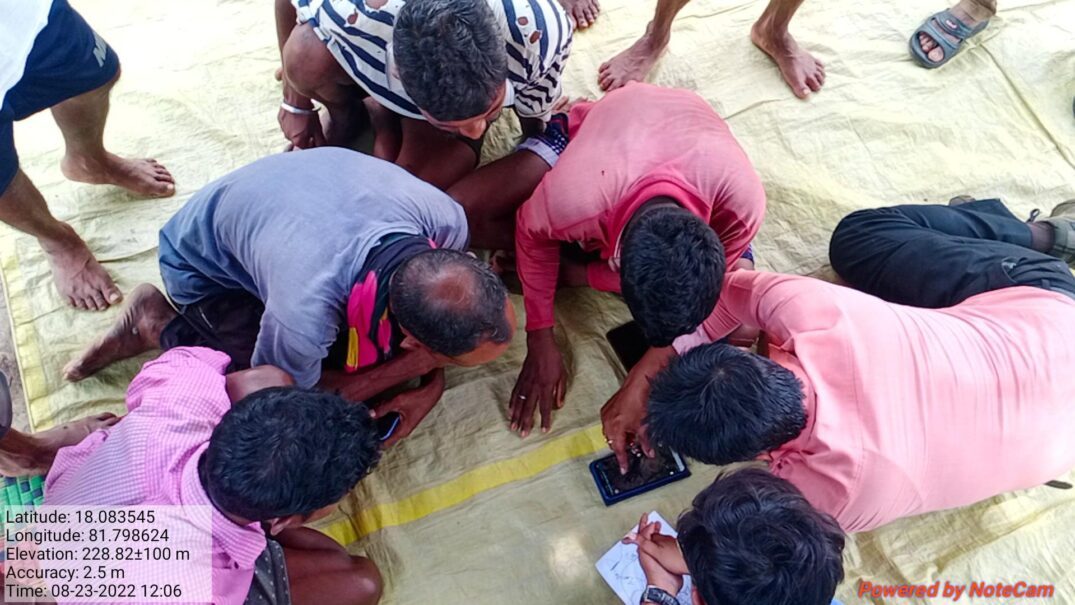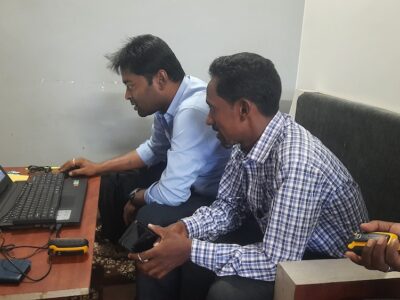ForestFi: Technology for Community-led Sustainable Forest Management in India

Sanjoy Mondal,Technology Specialist is showing the fuctioning of Handy GPS in phone to the community.
Forests in India have always been a source of seasonal income for local communities. They collect forest products, which are supplied to various sectors of the industry, generating revenue that supports their livelihoods. However, the benefits are not distributed equitably. The Indian School of Business (ISB) has launched the “Initiative on Forest Economy” (IoFE) to formalize the forest economy by establishing partnerships, providing a business model, and creating supportive tools and technology. The communities are involved actively in providing their inputs at each step of the way towards building these pillars of the initiative.
Technology plays a vital role at different stages of the forest economy, starting from quantifying select forest produce, assessing forest health and restoration capacity, mapping areas and optimizing logistics, and mechanising different processes. ForestFi is a technology stack that aims to create transparency and traceability, increase visibility in the forest economy, estimate the inventory of forest products, and monitor forest conditions for sustainable management and supply. It will create positive synergies in outcomes, such as improved implementation of the CFRR recognition process, increased productivity for communities, and sustainable forest management.
The ForestFi technology stack has several components that also play a critical role in community mobilization. One such component is RatiFi, an application designed to support local communities in generating Community Forest Resource (CFR) claims. The recognition of CFR rights in India is a challenging task because claim filing materials are scattered across multiple government departments. RatiFi standardizes the claim filing process and simplifies it, making it easier for Forest Rights Committees (FRC) to generate claims. The app enables FRCs to access documentation, such as Record of Rights and Forest Boundary maps, and a template for all the forms that need to be filled out. The app has made it easier for local communities to file CFR claims, which is a critical first step towards formalizing the forest-based economy.
HandyGPS is another critical component of the ForestFi technology stack. It is a mobile application that is used for geo-locating notable features and marking points along the forest boundary. The IoFE team conducted training workshops for volunteers to train them in the use of HandyGPS. Local communities in Jharkhand and Odisha are actively using this application for generating forest boundary maps. The Australian owners of HandyGPS are working with the IoFE team to add features specific to their requirements for a small annual subscription per user.
Participatory Forest Inventory Mapping is a methodology developed by the IoFE team to estimate the inventory of seasonal forest products in local forests. Local communities need this information to conduct business with large buyers in the industry and ensure a sustainable supply of raw materials. The methodology involves training women and youth to mark the location of individual trees and record the girth at breast height for a select species of value in the local forest economy. The IoFE team has already developed high-resolution estimates of the inventory for Sal in Jharkhand, for Bamboo in nine southern districts of Odisha, and for hazelnut clusters in the Chamba district of Himachal Pradesh.
The IoFE team has established methodologies for creating forest boundary maps at scale and estimating the inventory of a few seasonal forest products. A protocol for coordination among different stakeholders is in place, and the Identity, Access, and Management (IAM) system is under development. The IAM system will enable local communities to access information about their forests and forest products, enhancing their capacity to manage forests sustainably.
Other applications in the digital stack being actively developed are to facilitate the local recording of transaction-level data, create systems of traceability, and provide the basis for radical democracy in forest enterprises. The applications will enhance the capacity of local communities to use digital technology for sustainable forest management at the community and landscape levels.
The ForestFi technology stack will play a critical role in generating community claims on forest lands, increasing visibility in the forest economy, creating a system of transparency and traceability, estimating the inventory of forest products for sustainable management and supply, and monitoring forest conditions. These technologies will be optimised to support local communities to manage forests sustainably and formalize the forest-based economy, generating equitable benefits for all.
This article is part of a series showcasing Outstanding Success Stories from 2022 documented by the Initiative on Forest Economy (IoFE) team from BIPP, ISB.



